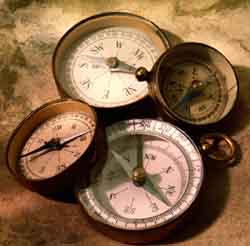Linked Molecules

Experimenters may be able to create a new molecular state in ultracold gasses, according to a theory in the 31 January print issue of PRL. At low temperature, and in the presence of an electric field, two polar molecules could form a weak link to make one “super molecule” while still far apart. Creating this state could give researchers a new tool to study intermolecular interactions.
The two polar molecules act like compass needles, which are small bar magnets. When the needles are far apart, both point north, but as they approach, the magnetic dipolar forces between them take over and cause the needles to attract and align head-to-tail. Similarly, two molecules with electric dipoles attract. “Creating this ‘field-linked’ state,” says John Bohn of the University of Colorado at Boulder, “essentially means grabbing the molecules to stop them from slamming into each other.”
Bohn and his Boulder colleague Alexander Avdeenkov theorize that the “grabbing” can result from a balance between an attractive and a repulsive force. As two head-to-tail-aligned, attracting molecules approach, there is some possibility that one will flip its orientation and create a repulsion. If the molecules begin to move apart, one might flip again, creating an attraction.
In the presence of an electric field, there is a specific distance where these flips can occur–where the attraction and repulsion energies are equal. Two molecules flipping back and forth from head-to-head to head-to-tail configurations at this separation form the stable “super molecule.” Quantum mechanics says that there is always some probability that these flips will occur and represents this bound condition as a single quantum state. Bohn and Avdeenkov have found that the probability is high enough for the molecules to remain linked for some time, separated by tens or hundreds of nanometers–much larger than the one-tenth of a nanometer size of either molecule alone. The properties of the field-linked state, including its binding energy and the distance between the molecules, depend entirely on the strength of the electric field.
Bohn and Avdeenkov applied their theory to OH molecules, but they expect it to work for other polar molecules as well. The key to putting the theory into practice will be cooling polar molecules below one kelvin–ideally into the microkelvin range. To date, the coldest ground-state molecules have been at about a hundredth of a kelvin, but Bohn says that several researchers are currently working to chill OH even further.
The new state could give researchers a new way to study molecular interactions and collisions in ultracold gasses. For example, researchers could hold the molecules a certain distance apart in the field-linked state, then turn off the field to release them and study the resulting collision.
Paul Julienne, of the National Institute of Standards and Technology in Gaithersburg, Maryland, says detection should be easy at low enough temperatures and thinks the study is significant. “We’re learning to control individual molecules or atoms by some kind of handle they have on them, like this external field control,” he says. “This could be a new tool to do the fundamental science of probing collision properties.”
–Lea Winerman
Lea Winerman is a freelance science writer.


